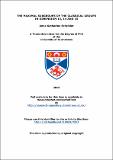Files in this item
The maximal subgroups of the classical groups in dimension 13, 14 and 15
Item metadata
| dc.contributor.advisor | Roney-Dougal, Colva Mary | |
| dc.contributor.author | Schröder, Anna Katharina | |
| dc.coverage.spatial | 198 | en_US |
| dc.date.accessioned | 2015-07-28T15:24:59Z | |
| dc.date.available | 2015-07-28T15:24:59Z | |
| dc.date.issued | 2015-11-30 | |
| dc.identifier.uri | https://hdl.handle.net/10023/7067 | |
| dc.description.abstract | One might easily argue that the Classification of Finite Simple Groups is one of the most important theorems of group theory. Given that any finite group can be deconstructed into its simple composition factors, it is of great importance to have a detailed knowledge of the structure of finite simple groups. One of the classes of finite groups that appear in the classification theorem are the simple classical groups, which are matrix groups preserving some form. This thesis will shed some new light on almost simple classical groups in dimension 13, 14 and 15. In particular we will determine their maximal subgroups. We will build on the results by Bray, Holt, and Roney-Dougal who calculated the maximal subgroups of all almost simple finite classical groups in dimension less than 12. Furthermore, Aschbacher proved that the maximal subgroups of almost simple classical groups lie in nine classes. The maximal subgroups in the first eight classes, i.e. the subgroups of geometric type, were determined by Kleidman and Liebeck for dimension greater than 13. Therefore this thesis concentrates on the ninth class of Aschbacher’s Theorem. This class roughly consists of subgroups which are almost simple modulo scalars and do not preserve a geometric structure. As our final result we will give tables containing all maximal subgroups of almost simple classical groups in dimension 13, 14 and 15. | en_US |
| dc.language.iso | en | en_US |
| dc.publisher | University of St Andrews | |
| dc.relation | J.N. Bray, D.F. Holt and C.M. Roney-Dougal. The Maximal Subgroups of the Low-Dimensional Finite Classical Groups. London Mathematical Society Lecture Note Series 407. Cambridge University Press, Cambridge, 2013. | en_US |
| dc.subject | Group theory | en_US |
| dc.subject | Classical groups | en_US |
| dc.subject | Classification of finite simple groups | en_US |
| dc.subject | Maximal subgroups | en_US |
| dc.subject.lcc | QA177.S3 | |
| dc.subject.lcsh | Finite simple groups | en_US |
| dc.subject.lcsh | Maximal subgroups | en_US |
| dc.title | The maximal subgroups of the classical groups in dimension 13, 14 and 15 | en_US |
| dc.type | Thesis | en_US |
| dc.type.qualificationlevel | Doctoral | en_US |
| dc.type.qualificationname | PhD Doctor of Philosophy | en_US |
| dc.publisher.institution | The University of St Andrews | en_US |
This item appears in the following Collection(s)
Items in the St Andrews Research Repository are protected by copyright, with all rights reserved, unless otherwise indicated.

